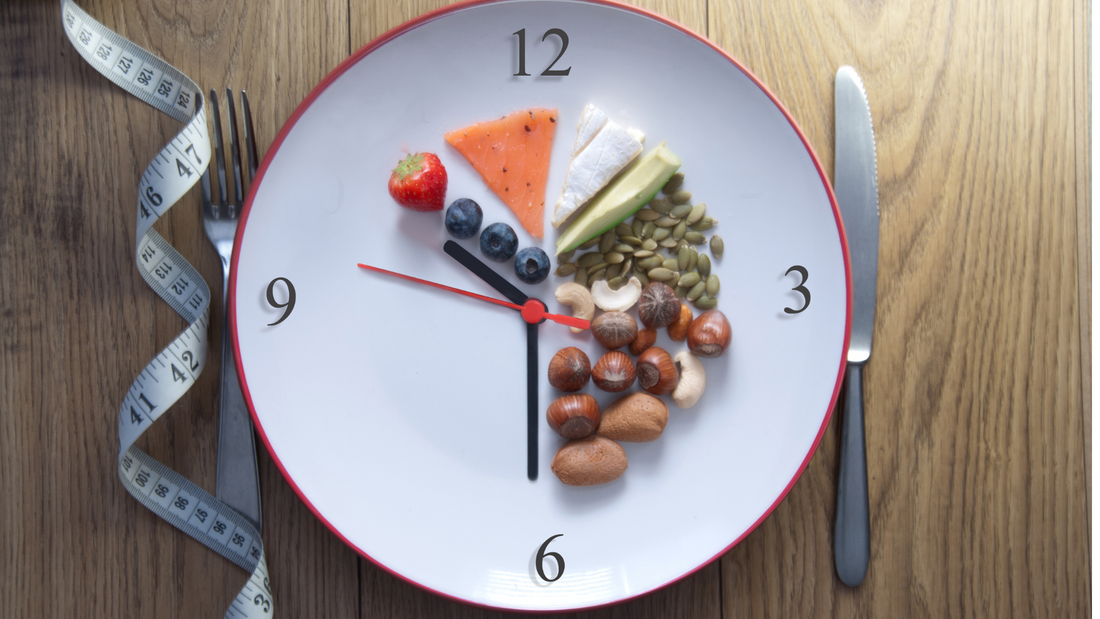Intermittent Fasting on Keto

Intermittent fasting (IF) is one of the most effective ways to supercharge your ketogenic lifestyle. By aligning your eating schedule with your body’s natural metabolic rhythms, you can fast-track ketosis, improve fat burning, and unlock powerful health benefits.
Let’s break down how intermittent fasting works, why it’s so effective on keto, and how to implement it for optimal results.
What is Intermittent Fasting?
Intermittent fasting is an eating pattern where you alternate between periods of fasting and eating. The most common method is the 16:8 schedule, which involves fasting for 16 hours and eating within an 8-hour window. Unlike traditional fasting, this modern approach offers all the benefits of fasting without the discomfort of prolonged food deprivation.
Why Intermittent Fasting Works So Well on Keto
The magic of intermittent fasting lies in its ability to force your body to use fat for energy. Here’s why:
-
Depletes Glycogen Stores:
- Your body stores glucose (sugar) in the form of glycogen in your liver and muscles. During fasting, these glycogen stores are depleted within 8-12 hours.
- Once glycogen is gone, your body has no choice but to tap into stored fat for energy, a process that accelerates ketosis.
-
Boosts Ketone Production:
- Without incoming food, your liver ramps up ketone production to provide fuel for your brain and muscles.
- This increases ketone levels in your blood, helping you achieve ketosis faster.
-
Reduces Insulin Levels:
- Fasting lowers insulin, the hormone responsible for storing fat. With lower insulin levels, your body becomes more efficient at burning fat.
-
Enhances Fat Adaptation:
- Regular fasting trains your body to rely on fat and ketones for energy instead of sugar. Over time, this metabolic flexibility makes staying in ketosis easier.
Key Benefits of Intermittent Fasting on Keto
-
Rapid Entry into Ketosis:
Fasting is one of the quickest ways to shift your body into a ketogenic state, particularly when combined with exercise. -
Burns More Fat:
- Research shows that fasting increases fat oxidation (the process of breaking down fat for energy).
- Fasting also triggers a hormonal shift that promotes fat loss, even without calorie counting.
-
Elevates Human Growth Hormone (HGH):
- Fasting increases HGH levels, which help preserve muscle, promote fat loss, and support anti-aging.
-
Triggers Autophagy (Cellular Cleansing):
- Autophagy is a process where your body cleans out damaged cells and replaces them with healthy ones.
- This reduces inflammation, improves cellular function, and supports longevity.
-
Improves Gut Health:
- Giving your digestive system a break allows your gut to heal and reset.
- When you eat again, your body is more receptive to nutrients, making your first meal post-fast incredibly impactful.
-
Simplifies Calorie Control:
- Limiting your eating window naturally reduces calorie intake without feeling restrictive.
- This helps you lose weight more effectively while staying full during your meals.
How to Start Intermittent Fasting
Follow these steps to ease into intermittent fasting and maximise its benefits:
1. Choose Your Eating Window
-
A common 16:8 schedule might look like this:
- Stop eating at 8 PM.
- First meal at 12 PM the next day.
-
If 16 hours feels too long, start with a 12-hour fast (e.g., 8 PM to 8 AM) and gradually extend your fasting window.
2. Stay Hydrated
- Drink plenty of water throughout your fasting period to stay hydrated and prevent hunger.
- Black coffee and unsweetened tea are excellent options, as they suppress appetite and support fat burning.
3. Break Your Fast Smartly
- Begin your eating window with nutrient-dense foods.
- Bone broth, leafy greens, or a keto-friendly smoothie are excellent options to nourish your body after fasting.
Advanced Fasting Strategies
For those looking to take their results to the next level, consider these strategies:
1. Fasted Workouts
- Exercising at the end of your fasting window (before your first meal) maximises fat burning.
- During fasted workouts, your body has no glycogen to burn and must rely on fat and ketones for energy.
2. Extend Your Fast
- Stretching your fasting window to 18-20 hours can enhance autophagy and amplify fat loss.
- Gradually work up to longer fasts to avoid burnout.
3. Limit Meals to Two Per Day
- Stick to two satisfying, nutrient-dense meals within your eating window.
- This minimises insulin spikes and makes calorie control effortless.
Foods and Drinks That Won’t Break Your Fast
When following intermittent fasting, the key is to avoid consuming anything that spikes your insulin or disrupts the fasting process. While water is the gold standard during a fast, there are several other options to keep you hydrated, energised, and satisfied without breaking your fast. Here's a detailed breakdown of what you can safely consume and why.
1. Water (Plain or Sparkling)
Why It Works:
- Water is essential for hydration and helps curb hunger during fasting.
- Sparkling water can add variety and a sense of fullness due to its carbonation.
Pro Tip:
- Add a pinch of Himalayan salt to your water to replenish electrolytes, especially during extended fasts.
2. Black Coffee
Why It Works:
- Coffee contains no calories or sugars, so it doesn’t interrupt your fast.
- The caffeine in coffee boosts metabolism, promotes fat oxidation, and suppresses appetite.
Pro Tips:
- Opt for freshly brewed black coffee to maximise antioxidant content.
- Avoid flavoured syrups, creamers, and sugar, which can break your fast.
3. Unsweetened Tea
Why It Works:
- Herbal, green, or black teas are calorie-free and can support hydration and digestion during fasting.
- Some teas, like green tea, contain catechins that enhance fat burning. Herbal teas like peppermint or chamomile can soothe your stomach.
Pro Tip:
- Stick to loose-leaf or bagged teas without added sweeteners or artificial flavours.
4. Apple Cider Vinegar (Diluted in Water)
Why It Works:
- A small amount of apple cider vinegar (ACV) diluted in water supports digestion and helps stabilise blood sugar levels.
- It can also help suppress appetite and reduce cravings during a fast.
How to Use It:
- Mix 1-2 teaspoons of ACV in a glass of water. Drink it in the morning or before meals for added benefits.
5. Electrolyte Water or Tablets
Why It Works:
- During fasting, your body loses electrolytes like sodium, potassium, and magnesium, which are crucial for maintaining energy and hydration.
- Replenishing electrolytes prevents fatigue, headaches, and muscle cramps.
Pro Tip:
- Use a no-calorie electrolyte supplement, such as electrolyte powders or tablets.
- Our Keto Gummies Complete Set offers a convenient way to replenish electrolytes without disrupting your fast.
6. Black Coffee with MCT Oil or Butter (For Extended Fasts)
Why It Works:
- Adding a small amount of MCT oil or grass-fed butter to your coffee doesn’t break your fast if consumed in moderation. These healthy fats provide energy and suppress hunger while keeping your insulin levels stable.
- MCT oil, in particular, is quickly converted into ketones, supporting fat burning and mental clarity.
How to Use It:
- Add 1 teaspoon of MCT oil or a small pat of butter to your coffee. Avoid going overboard, as larger amounts may disrupt the fasting process.
7. Bone Broth (For Longer Fasts or Refeeds)
Why It Works:
- Bone broth is rich in electrolytes, collagen, and amino acids, making it a gentle way to break a fast or sustain a prolonged fast.
- While it contains minimal calories, its nutrient density supports gut health and joint repair without causing insulin spikes.
How to Use It:
- Consume bone broth during extended fasts (24+ hours) or as your first meal when breaking a fast.
8. Plain Nut Milks (Unsweetened and Low-Carb)
Why It Works:
- Unsweetened almond, coconut, or macadamia milk is low in calories and carbohydrates, making it suitable in small amounts during fasting.
- These can be added to coffee or tea for a creamier taste without breaking your fast.
Pro Tip:
- Always check labels for added sugars or fillers. Aim for options with <1 gram of carbs per serving.
What to Avoid During Fasting
To maintain the fasting state and maximise benefits, avoid the following:
- Sugary Drinks: Soft drinks, juices, or sweetened teas spike insulin and break your fast.
- Artificial Sweeteners: Even calorie-free sweeteners like aspartame or sucralose can trigger an insulin response in some people.
- Caloric Creamers or Dairy Products: Milk, flavoured creamers, and yoghurts contain carbs and calories that disrupt fasting.
- Alcohol: Alcohol not only contains calories but also dehydrates the body and disrupts fat metabolism.
.
Common Challenges and How to Overcome Them
-
Hunger Pangs:
- Stay hydrated and keep busy to distract yourself.
-
Low Energy:
- Ensure you’re replenishing electrolytes like sodium, potassium, and magnesium.
- Our Keto Gummies Complete Set is a convenient way to stay energised and hydrated while fasting.
-
Cravings:
- Focus on whole, satiating meals during your eating window. Avoid processed snacks that can trigger cravings.
Takeaway: A Powerful Partnership
Intermittent fasting and the ketogenic diet are a powerful combination for achieving fat loss, improving metabolic health, and boosting overall well-being. By incorporating fasting into your routine, you can enter ketosis faster, burn fat more efficiently, and enjoy sustained energy throughout the day.
Ready to start your intermittent fasting journey? Check out our Keto Diet Guide for personalised meal plans and tips to optimise your results.


2 comments
Nice post.
How did I loose 29.6 Pounds in a month and Reversed my Diabetes…
Real Life experience Natural Steps + Gentle CTA
I didn’t follow any strict diet or fancy program. I just started being more mindful—cut down on processed foods, stopped eating after 8 PM, drank more water throughout the day, and made sure to get in at least 20–30 mins of walking, even if it was just around the block. I also focused on getting better sleep and managing stress because I noticed that really affected my cravings.
It wasn’t instant, but the weight started coming off slowly and steadily. After a while, I wanted to speed things up a bit without going back to crash diets. I found something that helped me boost the process naturally.
I hope you found these tips useful. If you want to take your health journey to the next level, I highly recommend something to fasten the results.For more information I would like you to watch this. Video..
https://tinyurl.com/Weightlossweb
Right now we are getting very good discount which is going to end by the end of this week.
Thank me later..
….
Hi,
I am just looking for a bit of advise please.
I am fasting from 8pm at night to 12pm lunch time the following day.
I start in the morning with 2 burn gummies after an30 min walk.
Whist still fasting until lunch time.
My concerns are that I am not having enough carbs. Some days it could be between 20 and 30 in a day. Also my calories are low .
Is this correct or am I’m not following the plan properly?